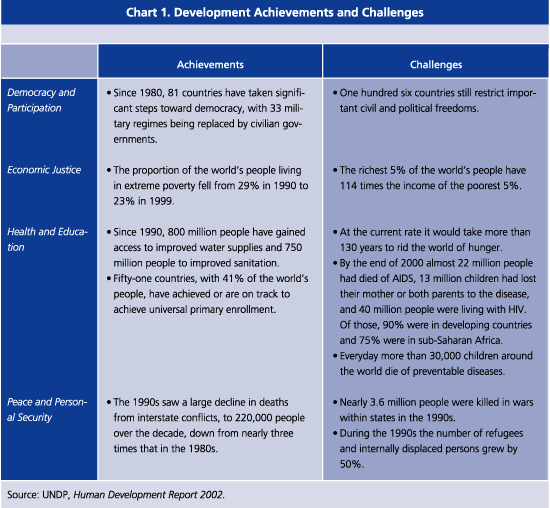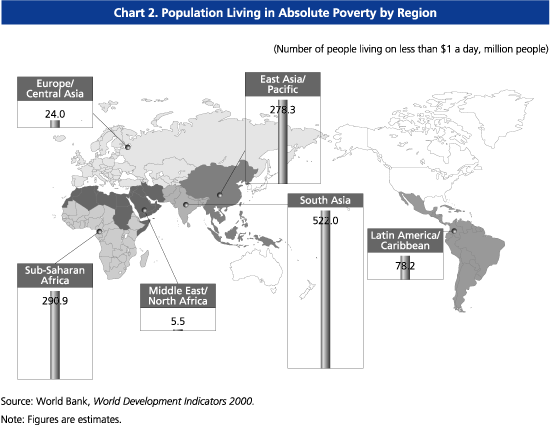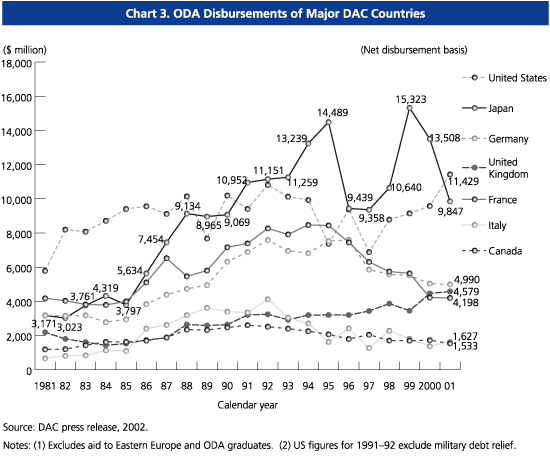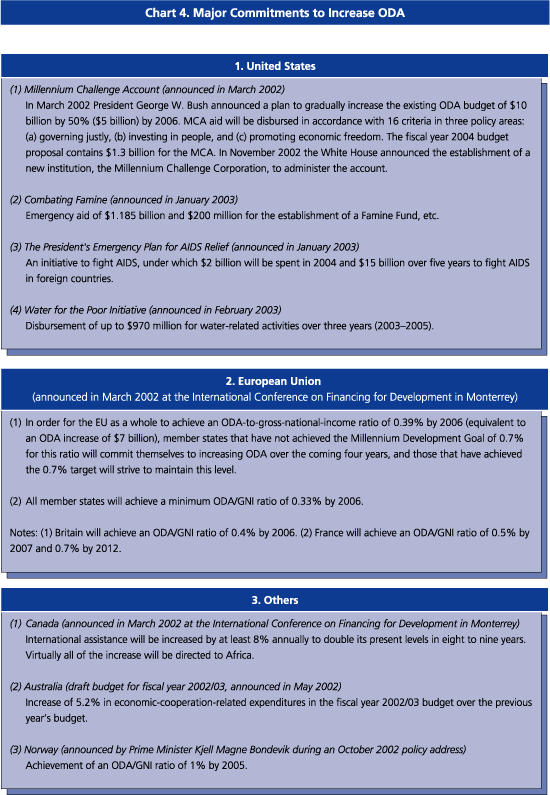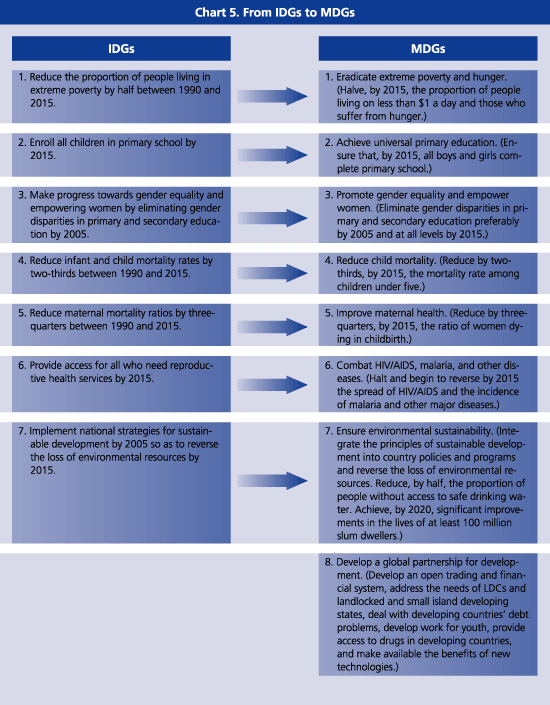Official Development Assistance (ODA)
Japan's ODA White Paper 2002
Part I. Trends in Japan's ODA in a Rapidly Changing World
Chapter 1
Development Issues as a Major Global Challenge in the 21st Century
The international community's efforts over the past several decades to overcome development issues have resulted in substantial improvements in many aspects. The infant and child mortality rate in low- and middle-income countries, for instance, has been halved over the past 30 years, as has the rate of adult illiteracy. In the countries of East Asia, where Japan has directed the bulk of its official development assistance (ODA), ODA-financed enhancements in economic and social infrastructure have attracted trade, investment, and other private flows and have fueled these countries' remarkable growth.
Nonetheless, many developing countries continue to be beset by various hardships, and new development challenges are emerging due to the advance of globalization. The economies of developing countries have also been damaged by a downtrend in private sector investment and other financial flows as a reflection of the global economic conditions. Furthermore, after the terrorist attacks in the United States on September 11, 2001, concerns about development issues are rising in the international community, due to the view that countries suffering from poverty and without good governance could become hotbeds of terrorism.
This chapter describes, first, the circumstances that have prompted the international community to give more attention to development issues. And major development issues will be analyzed through reference to major international conferences in 2002 where discussions about development were central. Then Japan's response to these major development issues will be explained.
Section 1. New Trends in Development Assistance
- The international community's interest in development issues has been rising. Since the beginning of 2002 the United States and European countries have successively announced drastic increases in ODA.
- Progress has been made in the sharing of development goals and building of development strategies in the international community.
- Japan believes in the importance of advancing poverty reduction through economic growth. It thus encourages trade and investment by lending support to the business sector and through other means.
(1) Heightened International Concern in Development Issues
Growing Seriousness of the Problem of Poverty with Advance of Globalization In August 2002 the World Summit on Sustainable Development (WSSD) was held in Johannesburg, South Africa, to review the efforts made under Agenda 211 in the decade since the 1992 United Nations Conference on Environment and Development (UNCED), or Earth Summit, in Rio de Janeiro, Brazil, and to discuss future measures. Active discussions were held on subjects ranging from global environmental issues to such development issues as poverty in developing countries.
Globalization has made the world richer and more convenient. At the same time, though, many people in developing countries feel they are not fully enjoying its fruits. The Johannesburg Plan of Implementation adopted at the WSSD states, "Globalization should be fully inclusive and equitable," and points out, "developing countries and countries with economies in transition face special difficulties in responding to those challenges and opportunities" created by globalization.
In fact, disparities have been widening with the advance of globalization. According to the World Bank, for example, the average income of the 20 most affluent countries is now 37 times the average income of the 20 poorest countries. This ratio has doubled over the past 40 years. The World Bank regards absolute poverty as living on less than $1 a day. By this measure, approximately 1.2 billion people, one-fifth of the global population, live in absolute poverty, and over 65% of them are in Asia. There has been a dramatic decline in the impoverished population in Asia owing to its remarkable economic growth, but it is still the home of the largest number of poor people in the world. And while Africa's impoverished population is smaller than that of Asia in absolute terms, it is growing rather than shrinking. Due to frequent conflicts and economic stagnation, moreover, Africa is a region that currently faces the greatest hardships.
After the terrorist attacks in the United States in September 2001, the importance of tackling poverty and widening disparities was again acknowledged in the international community, especially in the United States, and enhanced efforts toward development problems have been made.
Globalization has enabled the rapid movement of people, goods, services, and capital on a worldwide scale, but it has also heightened the need for concerted action by the international community to combat problems that cannot be solved by individual countries alone, including global environmental issues like global warming and desertification; HIV/AIDS and other infectious diseases; the proliferation of arms, such as small arms and land mines; drug smuggling; and transnational organized crime. The international community is strengthening its efforts to tackle these global issues as well.
Since the end of the Cold War, conflicts, especially civil wars that stem from religious and ethnic factors, have broken out frequently. In some cases, such as those in Timor-Leste and Afghanistan, uprisings and conflicts destroyed not only the economic infrastructure but also the basic structure of the state, including political and social institutions. Support for such countries where governments either do not exist or have extremely weakened governance capacity (failed states) has become an important task for the international community. Recently, attention has been focused on how the international community, including Japan and other interested countries, can support and promote the peace process and reconstruction in Sri Lanka, Aceh in Indonesia, and Mindanao in the Philippines. There are growing expectations that development assistance will play an even bigger role in the series of efforts, including conflict prevention to avert the outbreak of fighting, humanitarian assistance to ease the suffering of people affected by warfare, and post-conflict nation building and consolidation of peace.
1. Agenda 21 was adopted at the June 1992 United Nations Conference on Environment and Development (UNCED) as a concrete plan of action to be implemented by countries and international organizations to attain sustainable development toward the 21st century. It outlines specific programs for such social and economic aspects as population, poverty, and human settlement, as well as for such issues as the atmosphere, forests, the climate, water resources, biodiversity, and waste disposal.
(2) Enhanced Efforts by the International Community
Throughout the 1990s, while Japan contributed to the world's ODA in quantitative terms, among the developed countries as a whole, there was a downtrend in ODA, a situation that came to be characterized by "aid fatigue." However, factors mentioned above have resulted in remarkable changes and great increases in ODA by Western countries since the start of 2002.
A. Increase in ODA by Major Western Donors
The United States and the European Union (EU) both began to increase their development assistance in 2002. Prior to the start of the International Conference on Financing for Development in Monterrey, Mexico, in March 2002, the United States announced that it would increase its ODA between 2004 and 2006 from the present level of around $10 billion per year to $15 billion. At around the same time, EU countries announced that the EU as a whole would raise its ODA from the current 0.33% of gross national income (GNI) to 0.39% by 2006. Based on present levels, this represents an overall increase of $7 billion per year. Other nations that declared a policy of increasing their ODA in 2002 include Canada, Australia, and Norway. These moves have been enthusiastically welcomed by and have raised high expectations in the international community, especially among developing countries. This has built a positive momentum in the area of development in the international community.
B. Establishment of the Millennium Development Goals
In 1996 the Development Assistance Committee of the Organization for Economic Cooperation and Development (OECD-DAC) adopted "Shaping the 21st Century: The Contribution of Development Cooperation" as its New Development Strategy, identifying seven International Development Goals (IDGs). Japan played a pivotal role in the drafting of this strategy, such as by proposing specific goals. In September 2000 the United Nations Millennium Summit adopted the Millennium Declaration, which was later integrated with the IDGs into an enhanced common framework for the international community called the Millennium Development Goals (MDGs). The MDGs have become the shared development goals of the international community to make the basic conditions necessary for the future prosperity of humankind. The MDGs contain clear, quantitative goals with specific deadlines in such sectors as poverty reduction, primary education, health and medical care, gender, children, and the environment, so they emphasize concrete development achievements.
C. New Trends in Development Strategies
Now that development goals are gradually being shared internationally, development strategies have changed progressively. In the 1980s many developing countries received support for macroeconomic stabilization and social and structural reform, primarily from the International Monetary Fund (IMF) and the World Bank. This approach involved improving the macroeconomic policies of developing countries while reducing government intervention in markets as much as possible to encourage income growth through private-sector activity. Through this experience, it became clear that the key to ensuring the effectiveness of such assistance through mechanisms is ownership by the developing countries themselves in the reform process and the tailoring of support to match conditions in those countries.
Poverty, meanwhile, has been growing more serious in many parts of the world, and since the 1990s poverty reduction has been a focus of debate on development assistance; in 1996 OECD-DAC reaffirmed that poverty reduction is the ultimate goal of development assistance. In the process of this series of discussions, it has become apparent that sound economic policies and a sound institutional environment are essential to ensuring the effectiveness of development assistance in poverty reduction.
Comprehensive Development Framework The Comprehensive Development Framework (CDF) was proposed by World Bank President James D. Wolfensohn at the annual meetings of the IMF and World Bank in October 1998. The CDF is based on the view that developing countries must adopt sound macroeconomic policies and achieve balanced development of their structural, social, and human aspects simultaneously. Concretely, it calls for a comprehensive framework to achieve poverty reduction and sustainable development incorporating structural aspects (well-organized government, legal and judicial systems necessary for a market economy, closely monitored financial system, and protection of vulnerable members of society), human aspects (improvement of education systems and addressing of healthcare and population issues), physical aspects (water supply and sewerage systems, energy, improvement of transportation and telecommunications infrastructure, and protection of the global environment and culture), and strategies for specific areas (rural and urban development and fostering of the private sector), as well as appropriate macroeconomic policies. Moreover, developing countries must have ownership, which is adopted as one of the fundamental principles of DAC's New Development Strategy, in the implementation process. In other words, action in response to development issues should be taken under the leadership of developing country governments with the participation of various actors involved in development assistance (such as donor countries, international organizations, NGOs, and civil society).
- Emphasis on country ownership: A Poverty Reduction Strategy Paper (PRSP) is a development plan produced by the country itself. The country should take leadership in the development, implementation, monitoring, and evaluation of the PRSP.
- Emphasis on results (setting of specific targets): In the process of developing the PRSP, following the assessment of poverty and the analysis of the causes, the targets and indicators should be set. Then policies to achieve these goals are selected. Policies and assistance implemented are monitored and evaluated on the basis of these indicators.
- Comprehensive approach: Poverty reduction cannot be achieved only through economic growth. A comprehensive approach is required that includes income distribution, human resources development, and good governance.
- Partnership: The PRSP should be developed with the cooperation of a wide range of stakeholders, including donor countries, international agencies, NGOs, civil society, and the private sector. The partnership in the development of the PRSP spurs these related parties to consider the PRSP as their own and to cooperate in its implementation.
- Long-term perspective: Since achieving poverty reduction takes a long time, such as capacity building of the country, the planning and implementation of the PRSP must be based on a long-term perspective.
Poverty Reduction Strategy Papers Based on the CDF concept, Poverty Reduction Strategy Papers (PRSPs) are being drafted for the most impoverished countries. During the annual meetings of the IMF and World Bank in September 1999, a decision was reached at the Development and Interim Committees that heavily indebted poor countries (HIPCs) and countries targeted by the International Development Association (IDA) should be asked to prepare PRSPs in preparation for debt relief and provision of IDA loans. Since then PRSPs have been used as a measure for aid coordination relating to all aspects of development problems in developing countries. A PRSP is a comprehensive three-year economic and social development plan identifying priorities for the development strategy of the recipient country and the process of implementation. It is prepared with the participation of donors, international organizations, NGOs, and other parties and is utilized by all development partners as a guideline for the provision of support.
Tanzania's Poverty Reduction Strategy Paper (PRSP) was endorsed by the Board of Governors of the World Bank in October 2000. Tanzania was one of the first countries in the world where poverty monitoring was started. The Tanzanian Government, donor countries and organizations, NGOs, and university officials collaborated on the formulation of the Poverty Monitoring Master Plan, which was completed in November 2001. At present, PRSP poverty monitoring is being conducted under the following organizational setup.
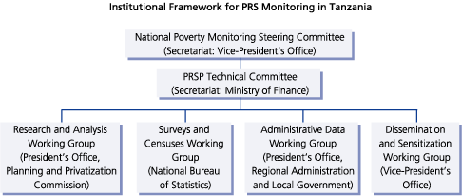
- Research and Analysis Working Group: Analyzes research findings, selects high-priority research and analysis topics, identifies what is needed to build the government's capacity for research and analysis, and coordinates communication with other working groups.
- Surveys and Censuses Working Group: Establishes methods for poverty monitoring and conducts surveys as set forth in the Master Plan.
- Administrative Data Working Group: Enhances quality of data collected regularly and voluntarily, mainly by local governments; improves data collection systems; and conducts training necessary for these tasks.
- Dissemination and Sensitization Working Group: Disseminates statistical data and findings of poverty analyses and provides information for the annual PRSP report.
A mechanism for poverty monitoring is thus being formed with the aim of implementing the PRSP and reducing poverty in Tanzania. However, because of the scarce budget of the government, shortages of human resources and equipment, and the inadequacy of the communication system linking regional governments and the central government, it will be a long time before accurate information is gathered and provided to the PRSP review.
Based on the conviction that poverty monitoring is a vital element in the implementation of the PRSP, Japan has played an active role in this effort ever since the PRSP was drawn up. Japan has worked with the UN Development Programme (UNDP) and another donor, the United Kingdom, to formulate a master program for tackling poverty and to carry out various types of surveys. In recognition of its contributions to the effort, Japan has been selected to serve on the National Poverty Monitoring Steering Committee as a donor member.
Developing country governments also develop fiscal and funding plans based on the PRSPs called Medium-Term Expenditure Frameworks (MTEFs), while the World Bank uses the PRSPs to prepare its lending plans, called Country Assistance Strategies (CAS). Donors and international organizations are also expected to refer to the PRSPs in exploring how they can cooperate and coordinate their support in an effective and efficient manner.
As of the end of 2002, 21 countries had finished formulating their PRSPs, while another 46 had produced draft versions. Now that so many countries have drawn up PRSPs, the focus of interest in the international community is shifting from PRSP formulation to actual implementation. Since the PRSPs are to be revised and amended as necessary during the implementation process, it is necessary to measure progress accurately through monitoring and evaluation.
D. Japan's Approach: Poverty Reduction through Economic Growth
The PRSP process will have a huge impact on the development policies of many developing countries and on the modalities of assistance provided by donor countries. While Japan is making utmost efforts toward the achievement of poverty reduction and other internationally shared development goals, Japan believes, based on the experience of East Asia, that economic growth is also an important means of achieving sustained poverty reduction. In concrete terms, assistance towards poverty reduction should be focused not only on social-sector support, such as education and health and medical care, but also on support in economic sectors, including improvements in economic infrastructure and legal systems and human resources development, which can spur economic growth in recipient countries through expansion of trade and investment, fostering of the private sector, and promotion of technology transfer. Because political, economic, and other situations vary widely from one developing country to the next, it is not always appropriate to apply the approach used in one country or region uniformly to other countries and regions. Instead, a variety of mechanisms suitable for the circumstances of each country and region should be utilized. Japan is working to gain developing countries' understanding for this approach through policy consultation and other forums so that it will be reflected in the countries' development policies and in the submission of formal requests.
Gradually, greater emphasis is now being given to growth sectors in the PRSP process. For example, Viet Nam's PRSP, approved by the World Bank in July 2002, is called the Comprehensive Poverty Reduction and Growth Strategy (CPRGS). This name reflects the priority given to economic growth by the Vietnamese government. The CPRGS gives greater weight to economic growth than the PRSPs developed by other countries. It includes strategies and numerical targets not only for poverty reduction but also for sectors that will promote sustainable growth. During the drafting process, Japan, together with the World Bank and other organizations, encouraged the Vietnamese government to give emphasis to economic growth in establishing specific indices and building strategies while respecting its ownership. However, the strategies for economic infrastructure are still not entirely adequate in the present CPRGS, and Japan took the initiative to reinforce economic infrastructure elements in the CPRGS at a meeting of the Viet Nam Consultative Group in December 2002.

